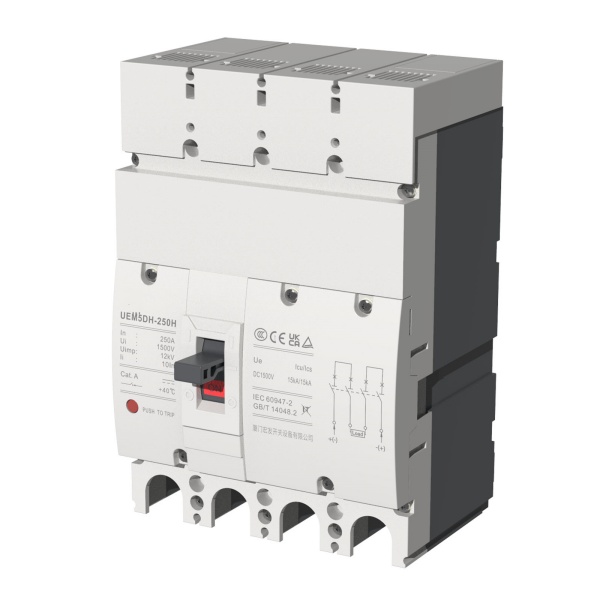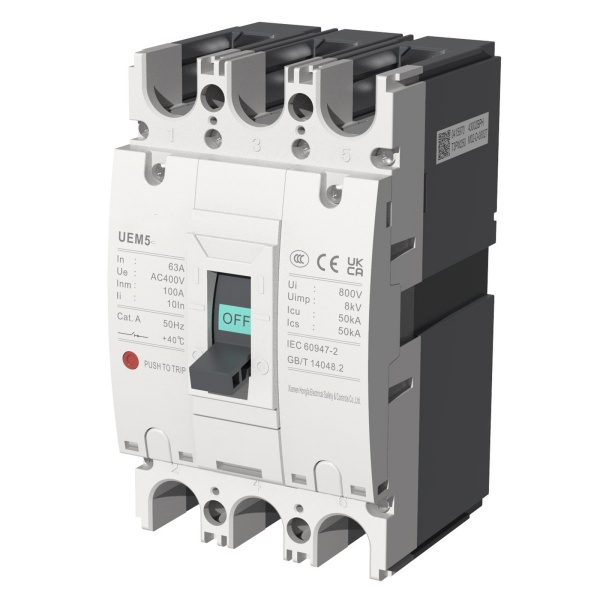As the core protection device in the electrical system, the normal operation of the circuit breaker is crucial. However, the mis-closing and mis-opening faults of the circuit breaker not only affect the safety of the system, but may also lead to serious consequences. This article will explore in depth the various causes of circuit breaker failures and their treatment methods, in order to provide practical reference for electrical engineers.

UEM5DH MCCB Breaker
1. The circuit breaker cannot be closed, and the reasons why the circuit breaker cannot be closed
①. The undervoltage coil does not work (the voltage is normal) (solution-replace the undervoltage coil);
②. Press the closing button, and the closing coil does not work when it is energized (solution-replace the undervoltage coil);
③. The closing button has poor contact (solution: replace the closing button);
④. The control circuit fuse is burned out (solution-confirm that the control circuit is normal and there is no short circuit and then replace the fuse) ⑤. The circuit breaker does not store energy (solution-check that the motor control power supply voltage must be ≥ 85%);
⑥. The closing electromagnet control power supply voltage is less than 85% (solution-the closing electromagnet power supply voltage must be ≥ 85%);
⑦. The closing electromagnet is damaged (solution – replace the closing electromagnet);
⑧. The secondary circuit of the drawer-type circuit breaker has poor contact (solution – shake the drawer-type circuit breaker back to the “on” position. Check whether the secondary circuit is connected reliably);
⑨. The universal conversion switch is in the stop position (solution – turn the switch to the left power supply or right power supply);
2. Judgment and treatment of “mis-trip” fault
If the circuit breaker automatically trips and the relay protection does not operate, and there is no short circuit or other abnormal phenomenon in the system when tripping, it means that the circuit breaker is “mis-tripped”. The judgment and treatment of “mis-trip” is generally carried out in the following three steps.
① According to the characteristics of the accident phenomenon, that is, before the circuit breaker trips, the meter and signal indication are normal, after the trip, the green light flashes continuously, the red light goes out, and the ammeter and active and reactive meters of the circuit breaker circuit indicate zero, then it can be judged as “mis-trip”.
② Check whether it is a “mis-trip” caused by accidental contact, misoperation, or mechanical vibration. At this time, the cause of the switch failure should be eliminated and power should be supplied immediately.
③ If power cannot be supplied immediately due to electrical or mechanical failure, the dispatcher should be contacted to deactivate the “mis-trip” circuit breaker for maintenance. Common electrical and mechanical failures are:
·Electrical failures include: protection misoperation or improper setting value, or current and voltage transformer circuit failure; poor insulation of the secondary circuit, two-point grounding in the DC system, so that the DC positive and negative power supplies are connected, which is equivalent to the relay protection action, generating a signal and causing tripping.
· Mechanical failures include: the tripping release mechanism cannot be maintained; improper adjustment of the positioning screw makes the three points of the crank arm too high; the spring of the trailer is deformed and the elastic force is insufficient; the roller is damaged; the slope of the trailer is large, it is not straight, or the roller has less contact surface on the trailer.
3. Judgment and treatment of “mis-closing” failure
If the circuit breaker closes automatically without operation, it is a “mis-closing” failure. Generally, the following methods should be used to judge and handle the problem. After inspection, it is confirmed that the circuit breaker has not been closed. If the handle is in the “open” position and the red light flashes continuously, it means that the circuit breaker has been closed, but it is “misclosed”. At this time, the circuit breaker that is mistakenly closed should be pulled open.
For the “misclosed” circuit breaker, if the circuit breaker is “misclosed” again after being pulled open, the closing fuse should be removed, and the electrical and mechanical reasons should be checked respectively. Contact the dispatcher to shut down the circuit breaker for maintenance. The reasons for “misclosing” may be:
① The positive and negative points in the DC circuit are grounded, so that the closing control circuit is connected.
② A component failure in the automatic reclosing relay connects the control circuit (such as the internal time relay normally open contact mistakenly closed), so that the circuit breaker is closed.
③ The resistance of the closing contactor coil is too small, and the starting voltage is low. When the DC system has a pulse instantly, it will cause the circuit breaker to close by mistake.

UEM5 AC MCCB Circuit Breaker
The handling of the circuit breaker’s misclosing and misopening faults requires comprehensive consideration of both electrical and mechanical factors. Through careful inspection and analysis, the cause of the fault can be effectively identified and appropriate measures can be taken to repair it. Whether it is a fault in the control circuit, a defect in the operating mechanism, or damage to mechanical components, timely diagnosis and treatment are the key to ensuring the stable operation of the electrical system. Therefore, regular maintenance and overhaul are essential to prevent and solve circuit breaker failures.
Post time: 7 月-18-2024


